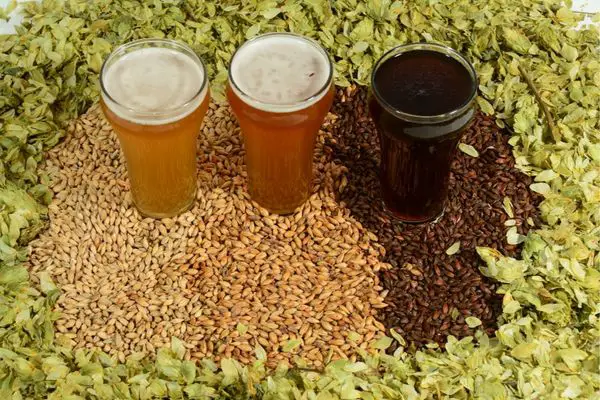I sometimes hear people asking about the differences between ale and mead. As a brewer, this hurts my heart a little, but while writing this post I might have understood why people confuse them.
Both are ancient drinks with rich histories, but they’re very different in flavor, ingredients and production.
So what separates these two boozy beverages and why do people confuse them?
Mead is made entirely from honey and ale is a type of beer made from malted grains (usually barley).
I think people are confusing them because they are both fairly old drinks and sometimes mead is perceived as a “kind of beer” drunk by the vikings. Which is not entirely untrue, but the brewing process is very different from that of beer!
In this blog post, we’ll explore the key differences between ale and mead and provide insight into which drink might be best for your next cozy night in or social gathering. So grab a mug, pour yourself a drink, and let’s dive into the world of ale and mead!
Why are mead and ale sometimes confused?
The confusion between mead and ale can be attributed to several factors. Firstly, both mead and ale have long histories and are deeply rooted in ancient traditions.
The origins of mead can be traced back thousands of years, with its presence in various cultures across the world.
Ale, on the other hand, has been a popular beverage since ancient times, particularly in European regions. This shared historical significance can lead to some misconceptions and assumptions about their similarities.
One possible reason for the confusion is the perception of mead as a “kind of beer” that was consumed by Vikings.

While there is some truth to this association, as mead was indeed enjoyed by Viking cultures, it is important to note that mead is not a type of beer.
The brewing process for mead differs significantly from that of beer. Mead is made exclusively from honey, which serves as the primary fermentable ingredient, whereas ale is a type of beer that is brewed using malted grains, usually barley.
Furthermore, the flavor profiles of mead and ale differ greatly. Mead tends to have a distinctively sweet and rich taste, often with floral or fruity undertones depending on the type of honey used.
In contrast, ales encompass a wide range of flavors and can exhibit varying degrees of bitterness, sweetness, and maltiness, depending on the specific style and brewing techniques employed.
Another aspect that may contribute to the confusion is the diverse range of mead and ale styles available today.
Both beverages have evolved over time, resulting in a multitude of variations and regional specialties. This can make it challenging for individuals unfamiliar with the specifics to differentiate between them accurately.
Ale and mead have different ingredients
Now that you understand the basic differences between ale and mead, let’s dive a little deeper into the ingredients used for each. Ale is brewed using malted barley, hops, water, and yeast.

The malted barley is heated to extract the flavors and sugars, which the yeast then eats and produces alcohol. Hops are added to balance out the sweetness of the malt and provide bitterness and flavor. Mead, on the other hand, is made purely from honey, water, and yeast.
The honey provides the sweet flavor and is the main ingredient, while the yeast slowly ferments the mixture to create alcohol. Mead may also include spices or fruits, but these are additional ingredients used to create a more complex flavor profile.
So the next time you order a pint or glass, you’ll know exactly what ingredients went into making your ale or mead.
As we’ve established, there are significant differences between ale and mead. One of the most striking is the set of ingredients used in each.
Ale is made from malted barley, water, hops, and yeast, whereas mead is made from honey, water, and yeast. The use of malted barley in ale gives it a distinct flavor and texture that differs from the sweet and smooth flavor of mead.

Additionally, the use of hops in ale contributes to its bitter taste and aroma, which is not present in mead. When it comes to ingredients, it’s clear that ale and mead are two entirely unique beverages with varying tastes, scents, and mouthfeels.
Ale is made from malted barley, hops, water, and yeast
Now that we know the main differences between ale and mead, let’s take a closer look at the ingredients used in ale. To make ale, you will need malted barley, hops, water, and yeast. The malted barley provides the fermentable sugars needed for the yeast to produce alcohol. Hops are used to add bitterness and balance out the sweetness of the barley.
Water is a crucial ingredient in ale brewing as it makes up most of the final product. Yeast plays a crucial role in the fermentation process by consuming the sugars from the barley and producing alcohol and carbon dioxide.
Remember, ale yeast is different from the champagne and wine yeasts used in mead making. Overall, the combination of these ingredients creates a range of flavors and styles for ale, from light and fruity to dark and smoky.
Mead is made from honey, water, and yeast
Mead, unlike ale, is made from honey, water, and yeast. This simple combination of ingredients creates a sweet, honey-forward beverage that has a distinct flavor profile compared to ale.

Mead is fermented using honey, which is a natural sweetener, and the resulting alcohol content can range from 7% to 20%. Mead can also be still or carbonated depending on the brewing process.
It is interesting to note that mead has a rich history, specifically in Nordic cultures, and can improve with age, similarly to wine. Mead is also best paired with light snacks like cheese and charcuterie. While ale is widely available in pubs and bars, mead is gaining popularity but can be challenging to find.
Other Differences between Ale and Mead
Now that we know the key ingredients of ale and mead, let’s look at the core differences between the two alcoholic beverages.
First, the ingredients used in ale and mead are fundamentally different. Ale is made from grains, typically malted barley, while mead is made from honey. Second, the fermentation process is distinct. Ale is brewed using a yeast that eats sugar and produces alcohol, while mead is fermented using honey, water, and yeast or other bacteria.
Third, the flavors are vastly different. Ale has a wide range of flavors, from light and fruity to dark and smoky. Mead, on the other hand, is typically sweet and honey-forward. Fourth, the alcohol content of ale and mead can differ widely, with ale ranging from 3% to 9%, and mead ranging from 7% to 20%. Fifth, carbonation levels can contrast quite dramatically.
Ale is typically carbonated, while mead can be still or carbonated. Sixth, aging characteristics are entirely different. Ale is best enjoyed fresh, whereas mead can improve with age similar to wine. Seventh, food pairings also differ significantly.
Ale pairs well with a variety of foods, while mead pairs well with cheese, charcuterie, and other light snacks. Eighth, history and cultural associations of ale and mead are also unique. Ale has a long history in Europe, while mead is often associated with Nordic cultures.
Ninth, availability can be quite different as well. Ale is widely available in pubs and bars, while mead is gaining popularity but can be harder to find. Lastly, the brewing process varies between the two beverages. Ale is brewed using heat to extract the flavors from the grains, while mead is made through the slow fermentation of honey and water.
1. Ingredients:
Now that we’ve covered the basics of ale and mead, let’s dive into their specific ingredients. Ale is primarily made from malted barley, water, hops, and yeast. These elements come together to create the wide range of flavors and strengths found in this type of beer. On the other hand, mead is brewed using honey, water, and yeast. The sweetness of the honey provides the fermentable sugars that allow the yeast to do its job. Compared to ale, mead has a distinct honey-forward flavor that pairs well with lighter snacks and cheeses. Whether you prefer the complex flavors of ale or the sweet simplicity of mead, these two beverages offer something for every palate.
2. Fermentation:
Now that we’ve covered the key ingredients used to make ale and mead, it’s time to dive into the fermentation process. Ale is brewed using a yeast that feeds on sugar and produces alcohol. This process is called alcoholic fermentation. Because the yeast consumes the sugar in the malted barley, hops, and water mixture, it transforms those sugars into carbon dioxide gas and alcohol. Mead, on the other hand, is fermented using honey, water, and yeast or other bacteria. Yeast ferments the honey, which converts the sugar in the honey into alcohol and carbon dioxide. Other bacteria can also be used in mead fermentation, such as lactobacillus or pediococcus, which can give mead a sour taste. Overall, the fermentation process plays a crucial role in the final flavors, carbonation, and alcohol content of both ale and mead.
3. Flavors:
When it comes to flavors, ale and mead couldn’t be more different. Ale offers a wide range of tastes, from light and fruity to dark and smoky, depending on the type of malted barley and hops used in the brewing process.
On the other hand, mead is typically sweet and honey-forward due to the honey used as the main ingredient. While ale can be carbonated for added effervescence, mead can be still or carbonated, providing you with a different mouthfeel altogether.
In terms of food pairings, ale goes well with a variety of dishes, from spicy curries to sweet desserts, while mead is best paired with cheese, charcuterie, and light snacks. So whether you’re looking for a refreshing beer or a sweet and honeyed beverage, ale and mead can cater to your specific taste preferences.
4. Alcohol content:
When comparing ale and mead, one of the key differences is their alcohol content. Ale typically falls between 3% and 9%, while mead can range from 7% to 20%.
This is due to the high sugar content in honey, which allows for a higher alcohol content in mead compared to ale. It’s important to note that alcohol content can also vary based on the type of mead produced, with session meads having the lowest alcohol volume and sack meads having the highest. When deciding between ale and mead, it’s important to consider your personal tolerance for alcohol and how it will affect your enjoyment of the drink.
5. Carbonation:
Ale is typically carbonated, while mead can be still or carbonated.
When it comes to carbonation, ale and mead couldn’t be more different. Ale is typically carbonated, which gives it a refreshing, bubbly consistency. Mead, on the other hand, can be still or carbonated, depending on the preference of the maker. Depending on the style of mead, a still mead can be a sweeter, smoother beverage, while a carbonated mead can be harder and lighter. This is an important difference to note for those who enjoy a certain type of carbonation in their alcoholic beverages.
6. Aging:
Ale is best enjoyed fresh, while mead can improve with age, similar to wine.
When it comes to aging, ale is best enjoyed fresh, while mead can improve with age. This is because mead is a lot more similar to wine than beer in terms of alcohol content and flavor, and as such, it can benefit from the same aging process.
Traditional mead can be aged for up to two to three years or more, allowing it to develop complex flavors and aromas. In comparison, ale is best consumed within a few months of production to maintain its freshness and carbonation.
Whether you prefer the immediate gratification of ale or the patience required for aging mead, both offer unique flavor profiles and can be enjoyed in different ways.
7. Food pairing:
Ale pairs well with a variety of foods, from spicy to sweet. Mead pairs well with cheese, charcuterie, and other light snacks.
When it comes to food pairing, ale and mead have their own unique strengths. Ale, with its wide range of flavors, can be paired with a variety of foods, from spicy dishes to sweet desserts. On the other hand, mead’s sweet and honey-forward taste pairs well with cheese, charcuterie, and other light snacks. It’s important to keep in mind that the alcohol content of mead can be higher than ale, so consider this when pairing with food. While both beverages have their own distinct food pairing strengths, ultimately it comes down to personal preference and finding the perfect match for your taste buds.
8. History:
Ale has a long history in Europe, dating back to ancient times. Mead has a rich history, often associated with Nordic cultures.
When it comes to the history of alcohol, ale has a long and established heritage in Europe. Its roots date back to ancient times when the Egyptians and Babylonians brewed beer-like beverages. Ale has since been associated with various regions in Europe, such as the UK and Germany. On the other hand, mead has a rich history and is often associated with Nordic cultures.
The word “mead” itself derives from the Old English “meodu,” and mead has been enjoyed for centuries in Nordic countries like Sweden, Norway, and Denmark.
Both ale and mead have fascinating histories that are deeply intertwined with the cultures they come from. The stories behind these drinks make them all the more enjoyable to savor, whether alone or in good company.
9. Availability:
Ale is widely available in pubs and bars, while mead is gaining popularity but can be harder to find.
If you’re looking to enjoy a pint of ale, you’ll have no trouble finding it at your local pub or bar. The popularity of ale has made it widely available and a fixture in many drinking establishments. However, if you’re looking for mead, it may be a bit harder to come by. While mead has gained popularity in recent years, it’s still not as mainstream as ale. You may have to seek out specialty stores or search online to find mead to try. But don’t be deterred, the hunt for a unique and delicious beverage is part of the fun!
10. Brewing process:
Ale is brewed using heat to extract the flavors from the grains, while mead is made through the slow fermentation of honey and water.
When it comes to brewing process, there are notable differences between ale and mead. For ale, heat is used to extract the flavors from grains such as malted barley, while mead is made through a slow fermentation process that relies on honey and water.
Ale requires the grains to be mashed and boiled before it goes through a fermentation process with yeast.
After the fermentation is completed, the ale is then typically carbonated before being served. On the other hand, mead relies on the natural sugars found in honey and requires no boiling or mashing. The ingredients are simply mixed together and left to ferment using yeast or bacteria. Unlike ale, mead can take several months to fully ferment and is typically not carbonated.
The slow fermentation process gives mead a distinct flavor profile and makes it a great option for those looking for a unique, honey-forward beverage.
Conclusion
In conclusion, while mead and ale share a historical connection and are both fermented beverages, they are fundamentally distinct in terms of ingredients, flavors, and production methods. Mead is made solely from honey, providing a sweet and unique character, whereas ale is a type of beer brewed from malted grains. By understanding these differences, we can appreciate the individual qualities that make each drink a fascinating and delicious part of our liquid heritage.




